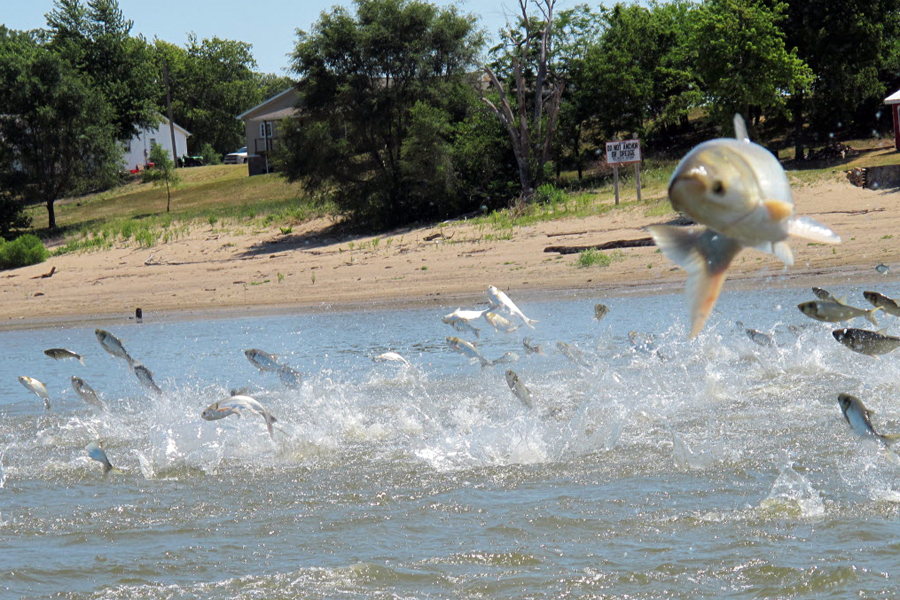Carpe diet? Chinese firm's plan to export Asian carp could help US waterways.
Loading...
| Chicago
A Chinese company is planning to open the first fishery in the US dedicated solely to the processing of Asian carp – an invasive species that environmentalists say is threatening the Great Lakes – and its export to markets in Southeast Asia.
In its announcement this week, the company, Two Rivers Fisheries, said it aims to pull up 10,000 of the fish daily from local waterways, although environmental science experts say it is too soon to say if the effort will make enough of a significant dent in the ongoing effort to keep the species from penetrating Great Lakes waters.
There are currently an estimated one million Asian carp in the Illinois River, a waterway that links to the Mississippi River where the carp originated and is connected to Lake Michigan through a series of artificial shipping canals near Chicago.
Even though a single Asian carp has been found lakeside of an electric barrier built to prevent a carp invasion, a coalition of neighboring states, including Michigan, Minnesota, and Wisconsin, worry that an imminent fish invasion threatens a $7 billion annual recreational and commercial fishing industry.
Two Rivers Fisheries says it plans to invest $2.5 million in building the fishery in Wickliffe, Ky., a city located about two miles south of the confluence of the Ohio and Mississippi Rivers. The company will purchase the fish from local fishermen, and process it for shipping overseas, where the fish is sold for human consumption and animal feed and where byproducts are used for products such as fertilizer.
“Our hope is that this facility benefits Kentucky’s waterways as well, removing Asian carp from the rivers and turning them into a positive resource,” company CEO Angie Yu said in a statement.
The idea of harvesting Asian carp for export to China was floated in 2010 by Illinois Gov. Pat Quinn, who said the opportunity would create jobs and income for fishermen along the Illinois River, where as much as 30 million pounds of Asian carp could be caught annually.
The state invested $2 million to upgrade private facilities downstate so they could start processing the fish, and a state program has even served more than 2,000 Asian carp meals to needy families over the past two years. According to researchers at Southern Illinois University, Asian carp dominate the Illinois River, making up about 63 percent of its fish population.
But the combined efforts are likely to thin the herd, not stop it, says Jonathan Freedman, a researcher with the Illinois Natural History Survey, a project associated with the Illinois Department of Natural Resources and the University of Illinois in Champaign-Urbana. Mr. Fredman says that, because fisheries are primarily interested in large fish greater than 16 inches in length, the younger carp will likely remain unscathed, allowing them to continue the species’ rapid reproduction cycle.
“You would have to process a lot of Asian carp to make a dent in the population. It’s certainly doable, but only time will tell,” he says.
Asian carp, which can weigh as much as 100 pounds, were originally used as bottom feeders to maintain catfish farms in the South. Over many years, the fish migrated up the Mississippi River, reaching as far north as an electric barrier in an artificial shipping canal located about 37 miles outside Chicago.
Since their discovery so close to a Great Lakes entryway, a legal battle has been waged. On one side, the coalition of states, which have argued in federal court for a permanent closure of the canal, and on the other, the city of Chicago, barging interests, and federal agencies that say not enough evidence exists to prove the fish has penetrated the barrier and that sealing off Lake Michigan from the canal would cost billions of dollars and take years to complete.
While Illinois officials have argued against permanent closure, Governor Quinn made comments last weekend suggesting he is considering reversing that position. Addressing a summit Saturday of the Council of Great Lakes Governors in Mackinac Island, Mich., Quinn said, “ultimately … we have to separate the basins. That is the ultimate solution,” the Associated Press reported.
Speaking to reporters afterwards, he clarified that he supported further study of the issue in order to determine costs. He estimated that such a project would cost about $3.5 billion, which would need backing from the federal government.
“There's no question it would be a very expensive endeavor. But if it’s necessary to have clean water in the Great Lakes in the 21st century, it's worth looking at,” he said.
Indiana and Illinois are the only two states that have traditionally opposed closure, saying it would result in billions of lost shipping dollars.
W. Lindsay Chadderton, director of the Great Lakes Aquatic Invasive Species program at The Nature Conservancy in South Bend, Ind., says Quinn’s comments are “clearly encouraging” in that he is recognizing “the solutions that can be put in place to achieve ecological separation, while maintaining the economic benefits the canal system provides.”
Mr. Chadderton agrees that such a massive engineering project will take years to develop and implement; to figure out the right solution may take up to five years.
“The reality is we’re not talking about something that is going to happen overnight,” he says. “As the economy improves, these sorts of projects will become an important part of the broader discussion of how we deal with our infrastructure.”






